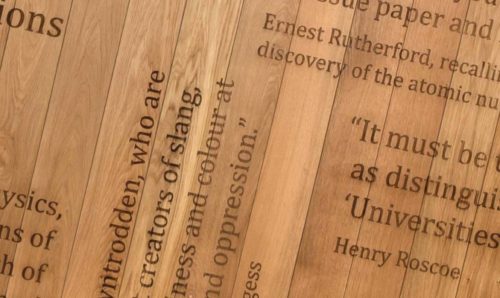Manchester researchers open a new chapter in the story of crystals
Departments Research impact and institutes 4th April 2017
Everyone is familiar with crystals; diamonds and sapphires are obvious choices but you can also add to that list snowflakes, sugar and salt. We probably all remember attempting to grow sugar and salt crystals at school by dissolving as much sugar or salt as possible into hot water, allowing the solution to cool slowly and watching the beautiful, large crystals then grow over the ensuing days.
But beyond the obvious crystals, we also use smaller and less well-known crystals in almost every aspect of our daily lives; our computers are full of chips that are made from crystals of silicon, the medicines that we take are, more-often-than-not, in the form of crystals, and low energy light bulbs are based on crystalline light emitting diodes (LEDs).
Crystals are everywhere and we make use of their unique properties in a myriad of strange but crucially important ways, but what is a crystal? It is a solid where the atoms or molecules that make up the solid are arranged in a very ordered and repeating arrangement in three-dimensions, just as the pattern on a wallpaper is repeated in two-dimensions. When atoms or molecules are arranged in such a fashion they often have useful properties that the individual atoms or molecules alone would not have.
A key example of this includes the zeolites used in the petrochemical industry; they are used as catalysts in the process of catalytic cracking whereby crude oil is refined into products such as petrol. The crystalline nature of the zeolite allows the resulting products to be ‘sorted’ by size and as such zeolites are often known as shape-selective catalysts.
But, as with everything in life, there are often mistakes in this regular pattern and the properties associated with these mistakes, or defects, are usually very different from the rest of the crystal. In fact, it is often the properties of the defects that are the most interesting aspect of our investigations, and this is the case in many of the electrical components in a computer.
The LEDs that make up your computer’s monitor rely on the imperfections in their crystalline structure to produce light, without these defects they would not light up.
Our work provides a new chapter in the 100-year-old story of how crystals grow. In the last decade, new microscopic techniques have meant that we are able to view crystals growing at the molecular scale which has provided vast amounts of new information and allowed us to apply this new knowledge to improving the effectiveness of crystals, like zeolites, that are used in industry.
To organise and understand this large amount of new information, new rules for crystal growth need to be developed and tested. In our latest paper – published by Nature and entitled ‘Predicting crystal growth via a unified kinetic three-dimensional partition model’ – we have developed new computer algorithms that are able to simulate, very quickly and efficiently, what we see in these microscopes for any of the millions of different types of known crystals.
These simulations are allowing us to think creatively about how we can adapt crystals to better suit their uses in industry. Better understanding crystalline structures could lead to more efficient drug designs, combating diseases where crystals are part of the disease itself (such as the hematin crystals that are grown in our blood cells in malaria), and helping to reduce the effects of global warming.
Michael Anderson,
Professor of Materials Chemistry and Scientific Director of the Centre for Nanoporous Materials, School of Chemistry
Header image Creative Commons via yellowcloud on Flickr.




